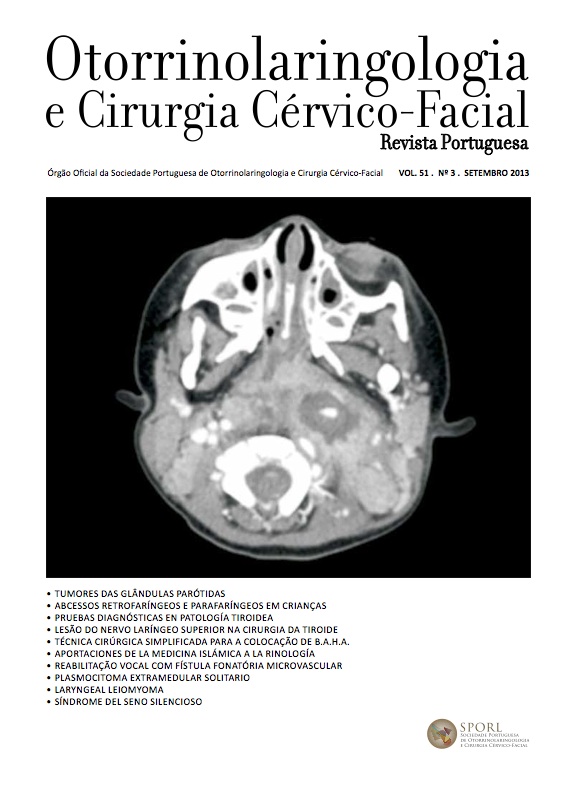Síndrome del seno silencioso: Una causa insospechada de retracción palpebral
DOI:
https://doi.org/10.34631/sporl.70Palavras-chave:
Síndrome del seno silencioso, Asimetría facial, Atelectasia del seno maxilar, Retracción palpebralResumo
El síndome del seno silencioso (SSS) consiste en una asimetría facial asintomática con retracción palpebral y enoftalmos, secundaria a una atelectasia crónica del seno maxilar. Es una patología muy rara. La revisión de la literatura muestra aproximadamente 120 casos publicados. Aunque con frecuencia este tipo de patología es presentada inicialmente al oftalmólogo, la mayoría de estos pacientes son enviados al otorrinolaringólogo para su adecuado tratamiento. Éste tiene dos objetivos: realizar una cirugía endoscópica para restaurar una adecuada ventilación del seno y, ocasionalmente, una reconstrucción del suelo de la órbita. Presentamos el caso de un varón de 17 años con SSS como causa de un proceso de expansión orbitaria, responsable de retracción palpebral y enoftalmos. Dado el caso presentado, se revisa detalladamente la literatura.
Downloads
Referências
Soparkar CN, Patrinely JR, Cuaycong MJ, Dailey RA, et al. The silent sinus syndrome. A cause of spontaneous enophthalmos. Ophthalmology. 1994 Apr; 101(4):772-8.
Montgomery WW. Mucocele of the maxillary sinus causing enophthalmos. Eye Ear Nose Throat Mon. 1964 May; 43:41-4.
Eto RT, House JM. Enophthalmos, a sequela of maxillary sinusitis. AJNR Am J Neuroradiol. 1995 Apr; 16(4 Suppl):939-41.
Numa WA, Desai U, Gold DR, Heher KL, et al. Silent sinus syndrome: a case presentation and comprehensive review of all 84 reported cases. Ann Otol Rhinol Laryngol. 2005 Sep; 114(9):688-94.
Sivasubramaniam R, Sacks R, Thornton M. Silent sinus syndrome: dynamic changes in the position of the orbital floor after restoration of normal sinus pressure. J Laryngol Otol. 2011 Dec; 125(12):1239-43.
Kass ES, Salman S, Montgomery WW. Manometric study of complete ostial occlusion in chronic maxillary atelectasis. Laryngoscope. 1996. Oct; 106 (10): 1255-8.
Suh JD, Ramakrishnan V, Lee JY, Chiu AG. Bilateral silent sinus syndrome. Ear Nose Throat J. 2012 Dec; 91(12):E19-21.
McArdle B, Perry C. Ethmoid silent sinus syndrome causing inward displacement of the orbit: case report. J Laryngol Otol. 2010 Feb; 124(2):206-8.
Naik RM, Khemani S, Saleh HA. .Frontal silent sinus syndrome. Otolaryngol Head Neck Surg. 2013 Feb; 148(2):354-5.
Wise SK, Wojno TH, DelGaudio JM. Silent sinus syndrome: lack of orbital findings in early presentation. Am J Rhinol.2007 Jul-Aug; 21(4):489-94.
Saffra N, Rakhamimov A, Saint-Louis LA, Wolintz RJ. Acute Diplopía as the Presenting Sign of Silent Sinus Syndrome. Ophthal Plast Reconstr Surg.2012 Dec 28. (Epub ahead of print)
Sesenna E, Oretti G, Anghinoni ML, Ferri A. Simultaneous management of the enophthalmos and sinus pathology in silent sinus syndrome: a report of three cases. J Craniomaxillofac Surg. 2010 Sep; 38(6):469-72.
Babin E, Bertrand M, Retout A, Gardea E, et al. Silent sinus syndrome with spontaneous orbital floor reconstruction. B-ENT. 2009; 5(2):125-8.
Barbosa M, Portmann D, Potena M, Rezende R, et al. Silent sinus syndrome: two cases report. Rev Laryngol Otol Rhinol (Bord). 2012; 133 (2): 101-3.
Babar-Craig H, Kayhanian H, De Silva DJ, Rose GE, et al. Spontaneous silent sinus syndrome (imploding antrum syndrome): case series of 16 patients. Rhinology. 2011 Aug; 49(3):315-7.
Mavrikakis I, Detorakis ET, Yiotakis I, Kandiloros D. Nonsurgical management of silent sinus syndrome with hyaluronic acid gel. Ophthal Plast Reconstr Surg. 2012 Jan; 28(1):e6-7.






